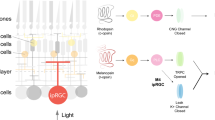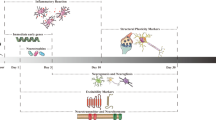Summary
We examined the effects of cerebellar cortical lesions upon conditioned nictitating membrane responses in rabbits. Using extended postoperative conditioning and unpaired presentations of the conditioned stimuli (CSs), we confirmed that combined lesions of lobules HVI and ansiform lobe abolished conditioned responses (CRs) established to light and white noise CSs. Extended retraining enabled some slight recovery of CR frequencies. Less extensive cortical lesions produced initial abolition of CRs but allowed more complete recoveries. Although CR frequencies and amplitudes were profoundly depressed by cortical lesions, unconditioned response (UR) amplitudes to periorbital electrical stimulation were enhanced. The dissociation of lesion effects upon conditioned and unconditioned responses is consistent with the suggestion that cerebellar cortical mechanisms are important for the learning and execution of eyeblink conditioning.
Similar content being viewed by others
References
Akaike T (1989) Electrophysiological analysis of the trigemino-olivo-cerebellar (Crura I and II, lobulus simplex) projection in the rat. Brain Res 482: 402–406
Berger TW, Thompson RF (1978) Neuronal plasticity in the limbic system during classical conditioning of the rabbit nictitating membrane response. I. The hippocampus. Brain Res 145: 323–346
Berthier NE, Moore JW (1980) Role of extraocular muscles in the rabbit (Oryctolagus cuniculus) nictitating membrane response. Physiol Behav 24: 931–937
Berthier NE, Moore JW (1986) Cerebellar Purkinje cell activity related to the classically conditioned nictitating membrane response. Exp Brain Res 63: 341–350
Berthier NE, Moore JW (1990) Activity of deep cerebellar nuclear cells during classical conditioning of nictitating membrane extension in rabbits. Exp Brain Res 83: 44–54
Brodal A, Kawamura K (1980) Olivocerebellar projection: a review. Adv Anat Embryol Cell Biol 64: 1–140
Brons JF, Woody CD (1980) Long-term changes in excitability of cortical neurons after Pavlovian conditioning and extinction. J Neurophysiol 47: 377–388
Clark GA, McCormick DA, Lavond DG, Thompson RF (1984) Effects of lesions of cerebellar nuclei on conditioned behavioural and hippocampal responses. Brain Res 291: 125–136
Clark RE, Brown DJ, Thompson RF, Lavond DG (1990) Reacquisition of classical conditioning after removal of cerebellar cortex in Dutch belted rabbits. Am Soc Neurosci Abstr 16: 271
Cody FWJ, Richardson HC (1979) Mossy and climbing fibre mediated responses evoked in the cerebellar cortex of the cat by trigeminal afferent stimulation. J Physiol 287: 1–14
Collewijn H (1981) The oculomotor system of the rabbit and its plasticity. Springer, Berlin
Collewijn H, Winterson BJ, Dubois MFW (1978) Optokinetic eye movements in albino rabbits: inversion in anterior visual field. Science 199: 1351–1353
Courville J (1966) Somatotopical organization of the projection from the nucleus interpositus anterior of the cerebellum to the red nucleus: an experimental study in the cat with silver impregnation methods. Exp Brain Res 2: 191–215
Davis KD, Dostrovsky JO (1986) Modulatory influences of red nucleus stimulation on the somatosensory responses of cat trigeminal subnucleus oralis neurons. Exp Neurol 91: 80–101
Disterhoft JF, Kwan HH, Lo WD (1977) Nictitating membrane conditioning to tone in the immobilized albino rabbit. Brain Res 137: 127–143
Gormezano I (1966) Classical conditioning. In: Sidowski JB (eds) Experimental methods and instrumentation in psychology. McGraw-Hill, New York
Gormezano I, Schneiderman N, Deaux E, Fuentes I (1962) Nictitating membrane: classical conditioning and extinction in the albino rabbit. Science 138: 93–106
Gormezano I, Kehoe EJ, Marshall BS (1983) Twenty years of classical conditioning research with the rabbit. In: Sprague J, Epstein AN (eds) Progress in psychobiological psychology, Vol 10. Academic Press, New York
Guillery RW, Kaas JH (1971) A study of normal and congenitally abnormal retinogeniculate projections in cats. J Comp Neurol 143: 73–100
Haley DA, Thompson RF, Madden J (1988) Pharmacological analysis of the magnocellular red nucleus during classical conditioning of the rabbit nictitating membrane response. Brain Res 454: 131–139
Hampson JL, Harrison CR, Woolsey CN (1945) Somatopic localization in anterior lobe and lobulus simplex of cerebellum in cat and dog. Fed Proc 4: 31
Harvey JA, Winsky L, Schindler CW, McMaster SE, Welsh JP (1988) Asymmetric uptake of 2-deoxy-D-[14C]glucose in the dorsal cochlear nucleus during Pavlovian conditioning in the rabbit. Brain Res 449: 213–224
Harvey JA, Yeo CH, Welsh JP, Romano AG (1990) Recoverable and non-recoverable deficits in conditioned responses (CRs) after cerebellar cortical lesions. Am Soc Neurosci Abstr 16: 268
Hesslow G (1989) Inhibition of conditioned eye-blink responses by stimulation of the cerebellar cortex. Eur J Neurosci Suppl 2: 188
Hesslow G, Hardiman M, Yeo CH (1990) Cerebellar lesions abolish eyeblink conditioning in the decerebrate rabbit. Eur J Neurosci Suppl 3: 301
Hiraoka M, Shimamura M (1977) Neural mechanisms of the corneal blinking reflex in cats. Brain Res 125: 265–275
Ito M, Yoshida M (1964) The cerebellar-evoked monosynaptic inhibition of Deiter's neurones. Experientia 20: 515–516
Ito M, Yoshida M, Obata K, Kawai N, Udo M (1970) Inhibitory control of intracerebellar nuclei by the Purkinje cell axons. Exp Brain Res 10: 64–80
Kelly TM, Zuo C-C, Bloedel JR (1990) Classical conditioning of the eyeblink reflex in the decerebrate-decerebellate rabbit. Behav Brain Res 38: 7–18
Larsell O (1970) The comparative anatomy and histology of the cerebellum from monotremes through apes. University Minnesota Press, Minneapolis
Lavond DG, McCormick DA, Thompson RF (1984) A nonrecoverable learning deficit. Physiol Psychol 12: 103–110
Lavond DG, Steinmetz JE (1989) Acquisition of classical conditioning without cerebellar cortex. Behav Brain Res 113–164
Lavond DG, Steinmetz JE, Yokaitis MH, Thompson RF (1987) Reacquisition of classical conditioning after removal of cerebellar cortex. Exp Brain Res 67: 569–593
McCormick DA, Lavond DG, Clark GA, Kettner RE, Rising CE, Thompson RF (1981) The engram found? Role of the cerebellum in classical conditioning of the nictitating membrane and eyelid response. Bull Psychon Soc 18; 103–105
McCormick DA, Thompson RF (1984a) Cerebellum: essential involvement in the classically conditioned eyelid response. Science 223: 296–299
McCormick DA, Thompson RF (1984b) Neuronal responses of the rabbit cerebellum during acquisition and performance of a classically conditioned nictitating membrane-eyelid response. J Neurosci 4: 2811–2822
McCormick DA, Steinmetz JE, Thompson RF (1985) Lesions of the inferior olivary complex cause extinction of classically conditioned eye-blink response. Brain Res 359: 120–130
Miles TS, Wiesendanger M (1975a) Organization of climbing fibre projections to the cerebellar cortex from trigeminal cutaneous afferents and from the SI face area of the cat. J Physiol (London) 245: 409–424
Miles TS, Wiesendanger M (1975b) Climbing fibre inputs to cerebellar Purkinje cells from trigeminal cutaneous afferents and the SI face area of the cerebral cortex in the cat. J Physiol (London) 245: 425–445
Nagao S, Ito M, Karachot L (1984) Site in rabbit flocculus specifically related to eye blinking and neck muscle contraction. Neurosci Res 1: 149–152
Norman RJ, Buchwald JS, Villabianca JR (1977) Classical conditioning with auditory discrimination of the eyeblink in decerebrate cats. Science 196: 551–553
Oakley DA, Russell IS (1972) Neocortical lesions and Pavlovian conditioning. Physiol Behav 8: 915–926
Oakley DA, Russell IS (1977) Subcortical storage of Pavlovian conditioning in the rabbit Physiol Behav 18: 931–93
Oscarsson O (1976) Spatial distribution of climbing and mossy fibre inputs into the cerebellar cortex. In: Creutzfeldt O (eds) Exp Brain Res Suppl 1. Afferent and intrinsic organization of laminated structures in the brain. Springer, Berlin, pp 34–42
Robinson FR, Houk JC, Gibson AR (1987) Limb specific connections of the cat magnocellular red nucleus. J Comp Neurol 257: 553–577
Schmaltz LW, Theios J (1972) Acquisition and extinction of a classically conditioned response in hippocampectomized rabbits (Oryctolagus cuniculus). J Comp Physiol Psychol 79: 328–333
Thompson RF (1986) The neurobiology of learning and memory. Science 233: 941–947
Welsh JP, Harvey JA (1989) Cerebellar lesions and the nictitating membrane reflex: performance deficits of the conditioned and unconditioned response. J Neurosci 9: 299–311
Woodruff-Pak D, Lavond DG, Thompson RF (1985) Trace conditioning: abolished by cerebellar nucleus lesions but not lateral cerebellar cortex aspirations. Brain Res 348: 249–260
Yeo CH (1987) Cerebellum and classical conditioning. In: Glickstein M, Yeo C, Stein J (eds) Cerebellum and neuronal plasticity. Plenum, New York, pp 321–338
Yeo CH (1991) Cerebellum and classical conditioning of motor responses. In: Wolpaw JR, Schmidt JT, Vaughan TM (eds) Activity driven CNS changes in learning and development. Ann New York Acad Sci 627:292–304
Yeo CH, Hardiman MJ (1988) Loss of conditioned responses following cerebellar lesions is not a performance deficit. Am Soc Neurosci Abstr 14: 3
Yeo CH, Hardiman MJ, Glickstein M (1984) Discrete lesions of the cerebellar cortex abolish the classically conditioned nictitating membrane response of the rabbit. Behav Brain Res 13: 261–266
Yeo CH, Hardiman MJ, Glickstein M (1985a) Classical conditioning of the nictitating membrane response of the rabbit. I. Lesions of the cerebellar nuclei. Exp Brain Res 60: 87–98
Yeo CH, Hardiman MJ, Glickstein M (1985b) Classical conditioning of the nictitating membrane response of the rabbit. II. Lesions of the cerebellar cortex. Exp Brain Res 60: 99–113
Yeo CH, Hardiman MJ, Glickstein M (1985c) Classical conditioning of the nictitating membrane response of the rabbit. III. Connections of cerebellar lobule HVI. Exp Brain Res 60: 114–126
Yeo CH, Hardiman MJ, Glickstein M (1986) Classical conditioning of the nictitating membrane response of the rabbit. IV. Lesions of the inferior olive. Exp Brain Res 63: 81–92
Zimny R, Grottel K, Jakielska D, Ostrowska A (1989) Topographic and zonal pattern of olivocerebellar projection to the paramedian lobule in the rabbit: an experimental study with an HRP retrograde tracing method. Neurosci Res 7: 173–198
Author information
Authors and Affiliations
Rights and permissions
About this article
Cite this article
Yeo, C.H., Hardiman, M.J. Cerebellar cortex and eyeblink conditioning: A reexamination. Exp Brain Res 88, 623–638 (1992). https://doi.org/10.1007/BF00228191
Received:
Accepted:
Issue Date:
DOI: https://doi.org/10.1007/BF00228191




